Introduction to the Lung
As Biological Unit
The (name organ)
Links and Connections
The (name organ) is connected to
Units to Unity
The (name organ) is part of
Dependence and Independence
The (name organ) cannot function alone and requires centrally based innervations and signaling in addition to the
Time Growth and Aging
Embryo highlights growth and aging highlights.
Space
The (name organ) space lies within the
Forces
Forces that relate to (name organ) function include….
Interactions
While it …
States of Being Health and Disease
During health …..
The introductory module is outlined below in keeping with the stepwise approach to learning. Each of the categories discussed below are described in a few sentences which progress in complexity as the project unfolds. Thus the intent is to paint a broad picture soas to give us a starting point for the learning, and to give context to the detail to come.
Biological Units
In the world of the lung a reasonable starting structural and functional unit is the alveolus. The tubular airways are the specialised conduits for one of the the many links between the alveolus with its surrounding environments. As in all instances in biology the alveolus is made of smaller parts which for the sake of simplicity will be discussed futher as the module advances. The alveolus joins with other alveoli to form the lobule, and the lobules join to form segments, which in turn form lobes which combine to form the lungs themselves. The respiratory bronchioles join to form the terminal bronchioles, which in turn join to form brochioles proper, which subsequntly become segmental bronchi, lobar bronchi, mainstem bronchi and then the trachea. The traches communicates with the outside world via the oropharynx. The lungs are protected and supported by a double layer of outer capsule called the pleura, with the rib cage, associated muscles, and skin representing additional layers of support and protection.
Structure and Function
Structure and function of the lung work hand in hand. The order of one is dependant on the order of the other and similalrly when there is disorder of one there is inevitably disorder of the other. In the study of structure and function we tend to separate the two in an attempt to understand each of them, but of course in biology they are inextricably linked and dependant on one another. Within the realm of the biological units, common structural features and functional features exist,whether we are observing the cell , the tissue, the organ, the body or the larger communities.
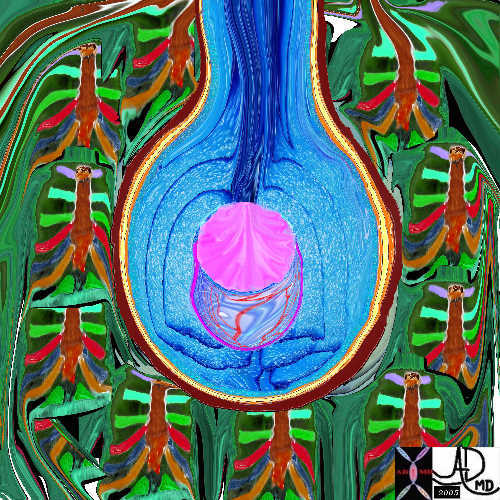 The Chest Wall The Lungs The Airways and The Alveoli The Chest Wall The Lungs The Airways and The Alveoli |
| The five major layers that keep the air moving include the outer bony cage, the muscular layer represented in maroon, the pleural complex (orange yellow orange) the lung (blue) and surfactant within the alveolus. (pink) Courtesy Ashley Davidoff MD. 42530b05b09b01a08 Davidoff art |
As we progress through the module there is a recurring pattern of the dual function of the respiratory apparatus – an airway system that transports the air, and an exchange system that enables transfer of the gases across the alveolar membrane.
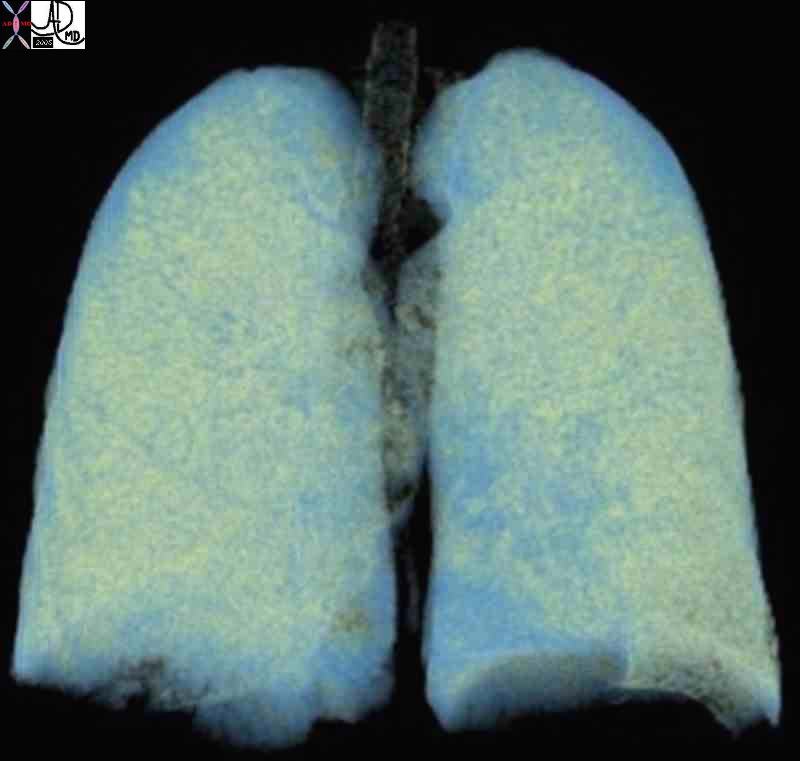 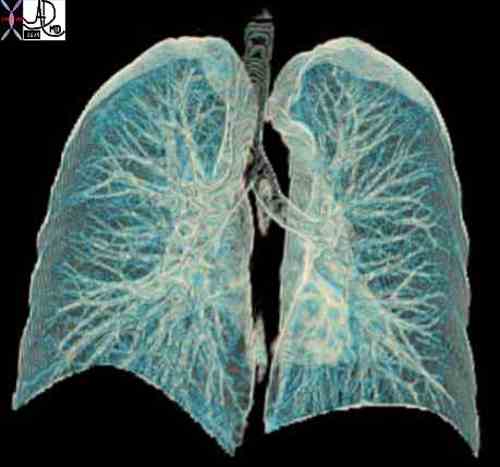 Lung Structure Lung Structure |
| There are two major functional components to the lungs; the transport system and the exchange system. The first image is a reformatted image in the coronal plane which reveals the transport system of the lungs. The second image is a surface rendering of the lungs which reveals the parenchymal component which functions as the gas exchange system. The tree like features of the lungs is exemplified by an infrastructure of dividing branches which subserve the leaves – in essence a tubular system serving the factories of gas exchange.
Courtesy Ashley Davidoff MD 32634d02 32634b02 |
The lungs are part of a larger system called the respiratory system. The role of the lungs is to deliver ambient air (ventilation) to the alveoli and to act as the agent for gas exchange by contributing one layer of epithelium to the bilayered membrane, a double layer which serves as the ultimate interface for gas exchange. The primary role of the pulmonary arterial circulation is to transport blood to the alveolar interface (perfusion) and to also play a part in the exchange of carbon dioxide and oxygen by providing the second layer of the bilayered filter. It is the homeostatic aim of the body to match the ventilation with the perfusion, in order to maintain uniform ventilation (V) to perfusion (Q) ratio (V/Q).
The lungs are exposed directly to the air in the atmosphere and to the blood within the circulatory system. Through the lungs the blood is therefore exposed to the atmosphere, which on the one hand contains life sustaining oxygen but on the other can present a hostile environment filled with microorganisms, industrial chemicals, and toxic fumes.
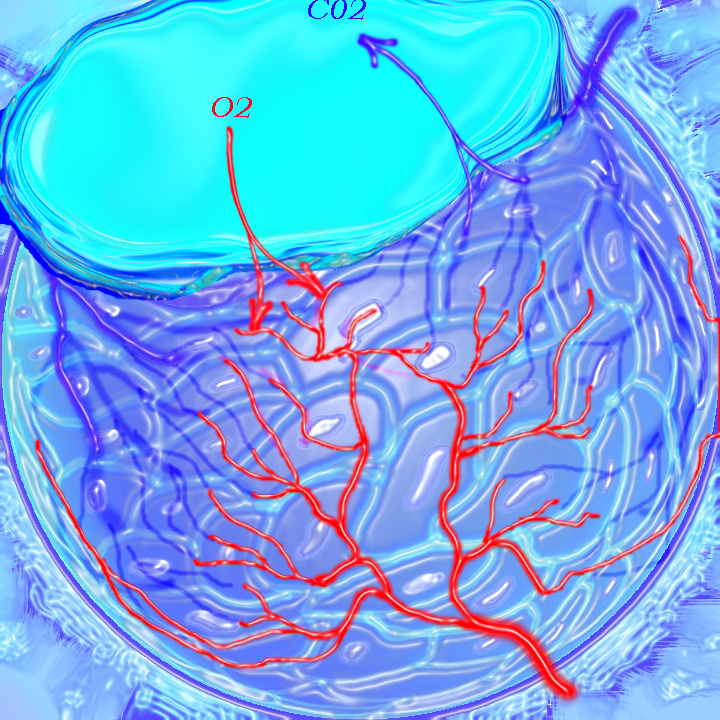
Alveolus |
| In this diagram a single alveolus is outlined with its surrounding arteriole, venule, and capillary network. The process at the alveolar end is a simple exchange. Life sustaining oxygen is received by the hemoglobin and toxic carbon dioxide is excreted. Although this exchange occurs in the respiratory bronchioles alveolar ducts and alveolar sacs, the alveolus is the prime site of gaseous exchange.
Image courtesy Ashley Davidoff MD 42438b03 |
From a structural point of view the lungs are voluminous and large structures, dominating the chest cavity, shaped like elongated pyramids individually and together form a bell shapedstructure. They are found in the chest cavity, one on the right side and one on the left. The lungs are made of expandable, sponge-like tissues. Their close proximity to the heart and circulatory system allows for rapid exchange of gases between the air and the circulatory system as noted above. This function is easily accomplished during rest, where resting respiratory rate in an adult is about 12 breaths per minute and heart rate 72 beats per minute. During exercise the respiratory rate can increase to 40-50 breaths per minute and the heart rate, increasing in concert, can reach 180-200 per minute. The interface of circulation with the respiratory system has to be sufficiently equipped to allow delivery, uptake, and exchange of gases at this accelerated pace. The key soldier in the exchange of oxygen is a complex protein called hemoglobin which lies in the red cell.
I imagine the hemoglobin molecule scurried by the forces of the right ventricle into the pulmonary circulation. As it enters the chambers of exchange, the open windows of the lungs herald the fresh air. Under basal conditions, the hemoglobin gnome can work at a leisurely pace filling his baskets with oxygen. Under exercise conditions he has to start working like crazy, grabbing molecules of oxygen and stacking these into his storage baskets, surrounded by an accelerated pace with gale-like air forces and flood-like blood conditions. Hemoglobin is a remarkable molecule and can adapt its function to these extremes in physiology.
Carbon dioxide from bodily metabolism is dissolved in the blood. Exchanges between the circulation and alveoli occur rapidly and efficiently across the alveolar membrane due to differences in the partial pressure of gas between the blood and the alveoli.
The presence of a structure in the body that is almost totally filled with air makes it a unique, challenging, and rewarding organ to examine clinically and radiologically. Examination of the lungs with a stethoscope enables the clinician to evaluate inspiratory and expiratory movement of air. Some pathologic conditions, including aspiration of a foreign body, collapsed lung, or inadvertent intubation of the bronchus, result in airway obstruction. In these conditions there is no air entry into the affected bronchus and subtended lung. The clinical finding of the lack of air entry, based simply on the lack of air sound, can be a life saving diagnostic maneuver.
Unusual but interesting words are used to describe the sounds of air character and movement on clinical examination. These include percussion, tactile fremitus, bronchophony, whispering pectoriloquy, and egophony and relate to the wayair moves through the airways, and how the transmission may change when there is fluid in the pleural space or in the lungs. When the air mixes with the fluid, characteristic sounds such as rales and crepitus will result.

Chest of Fruit |
| This “Chest of Fruit” with the red pepper for the heart and clusters of grape-like oversized alveoli speaks for itself – The image provides a brief respite from the serious depths of our discussion about odd sounding terms for odd sounding breath sounds.
Davidoff, M.D. |
Links Connections
The lungs onn the one end are conneted to the outside environment, connected o each other via the airways and connected to the rest of the body via both the systemic and the pulmonary circulation of arteries, veins, and lymphatics. It has intimate connection with the rest of the nervous system through the sympathetic and parasympathetic nervous system, while connective tissue, ligaments, mesenteries and cement matrix bond and link its tissues.
 The Pulmonary Artery – One of the Links to Other Systems The Pulmonary Artery – One of the Links to Other Systems |
| This is a normal digital pulmonary angiogram with arboristaion of the vessels to quarternary branches, almost to arterioles. Note the acute angles of the branches as they come offf the mother vessel. Courtesy Ashley Davidoff MD. (27655 27657 27658 27659 27660 27661 27662) |
Uniqueness
The structure and function of the lung is absolutely essential and unique. From a structural pont of view fr example there is no other structure that has its spongy feel, and no other structure can perform its delivery and exchange of gases in the way that it does. The kidney is the other large filter in the body, but it is specialised to filter fluids rather than gases. As each cell is studied in depth, morphological uniqueness will be appreciated in the same way that each human being is recognized as unique.
Dependance and Independance
The lung cannot function alone. On the one end it needs the outside environment for its raw material, and its vascular connections to deliver its products. It needs the nervous system to control its function, the endocrine system and nutritional system of the body to maintain its metabolism and minute to minute viability, and the filtering function of the kidneys to keep a clean environment. The bony rib cage and associated muscular systems are vital to help move the air back and forward. and protect the delicate tissue. It needs the macrophages and the reticuloendothelial system to protect it from the chemical and biological environment.
Time Growth and Aging
At 4 weeks gestation the lung grows from a ridge of endodermal tissue that participates in the formation of the ventral foregut. The developing airways have buds of endoderm that are associated with and grow with the dividing tubular system that in turn develop into the lung parenchyma. During gestation the lungs are filled with fluid and on first breath at birth are expanded with air and instantaneously assume their function as the gas exchange system of the body. Growth in volume and size occurs with time, but like many other organs start to lose elasticity with time but in the absence of any significant disease age well.
Space
Space is a second element that is inextricably linked to biology. The lungs occupy almost the entire chest cavity and they need the space in order to provide optimal gas exchange functionality. Diseases that trap air such as emphysema, lead to a loss of functional space, eve nthough the lungs are larger in size and take up more space. Encroachment on anothers space is a physical and moral transgression.
Forces
In addition to space and time, there are other forces in the respiratory sytem that are needed and used to enable the lung to execute its function. The negative intrathoracic pressure created by the downward movement of the diaphragm and outward movement of the chest wall allows for a gradient to be created between the relatively positive pressure in the environment and the relatively negative pressure in the chest allowing for air flow. The elastic nature of the lung tissues enable the lung and chest to move back to original non stretched position causing the chest cavity to compress and thus resulting in a relatively positive pressure in the chest compared to the environment. Outward flow of gases during expiration is thus facilitated. With each inspiration the oxygen concentration on the alveolar side is relatively high compared to that in the capillaries circulating through the lung, creating a gradient across the membrane. Diffusion of oxygen across the alveolar membrane thus results. The reverse is true with carbon dioxide which finds its way from the capillary system into the alveoli by a carbon dioxide gradient across the membrane. Surface tension is maintained in the alveoli by the presence of surfactant enabling the alveoli to stay open .
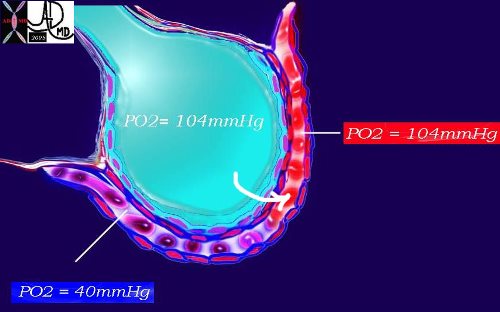 Oxygen and Carbon Dioxide Gradients Oxygen and Carbon Dioxide Gradients |
| This diagram again shows the alveolus in teal, the arteriolar component of the capillary with red cells in blue and venular component replenished by oxygen in red. As noted above, the PO2 of the arterial blood is 40mmHg while the inspired air is 104mmHg. A pressure gradient thus exists and diffusion from the high to the low pressure occurs with a net movement of oxygen into the blood to equilibrate the pressure. Venous blood is now rich in oxygen with a PO2 of 104mmHg.
Courtesy Ashley Davidoff MD. 42445b08b Davidoff art |
Flow: Basic Principles
The function of air transport is the domain of the tracheobronchial tree, which as a tubular system has to obey the universal principles of flow within a tube. At the terminal end of these tubes are epithelial layered grape-like clusters where gas exchange takes place. The principles of exchange of gases across a membrane are also universal in the body. If you understand flow in tubes, and exchange of gases chemicals and molecules across a membrane, you can apply the understanding to many aspects of body function.
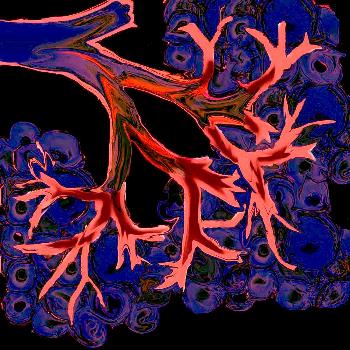
Terminal bronchioles and alveoli |
| This diagram illustrates the branching pattern of the tracheobronchial tree that extends from the bronchi to the terminal bronchioles transitioning into the alveoli via the alveolar sacs.
Courtesy Ashley Davidoff MD 32645b04b04 |
Flow will only occur when a pressure difference exists between the two sides of the tubes. When we breathe in, the intercostal muscles contract and expand the chest laterally and the diaphragm moves down, increasing the volume of the chest cavity in a craniocaudad dimension. As a result the alveoli expand, causing a negative pressure in the alveolar side of the tubes. The pressure in the atmosphere is higher and thus air will flow from a high pressure system to a low pressure system – i.e. from the atmosphere to the lungs. During expiration, the elastic nature of the chest, with the relaxation of intercostal muscles and diaphragm, result in a return of the chest to its preinspiratory position. The chest therefore is in a contracted size, causing a relative increase of pressure in the alveoli when compared to the atmosphere, and air will flow from the alveoli to the atmosphere. Inspiration is therefore an active process requiring energy and muscle contraction, and expiration is a passive process of elastic recoil.
Velocity of flow relates to factors such as tubular diameter, resistance, friction, and pressure differences, as well as the nature of the medium being transported. Velocity of flow will also depend on whether the flow is laminar or turbulent. If it is laminar, it will be governed by Poiseuille’s law, which states that velocity of flow is directly proportional to the driving pressure.
Poiseuille’s law – for laminar flow
Volume flow rate = pressure difference
resistance
= P1-P2
R
= pressure difference X radius4
8/pi viscosity X length
As velocity increases however, flow tends to become turbulent and Poiseuille’s law does not apply. Flow tends to be laminar when the tubes are small, and turbulent when the tubes are large or when there are irregularities in the walls. Thus flow in the larger parts of the airways tends to be turbulent and in the smaller tubes it is laminar. Under resting conditions, laminar flow exists from the medium-sized bronchi onward down to the bronchioles. During exercise, the air flow is accelerated, and laminar flow may be confined only to the very small airways. Laminar flow is quiet while turbulent flow is noisy. Thus when your doctor or nurse places a stethoscope on your chest and asks you to breath in and out, they are listening to the turbulent flow in your larger airways. The audible “huffing and puffing” that occurs with exercise results from greater forcefulness of the muscles in an attempt to get more air in and out, and the turbulence becomes audible even without the stethoscope.

Laminar flow |
| This diagram reflects the laminar flow showing the almost parallel lines of flow that is characteristic of flow in the smaller tubes. Under resting conditions, laminar flow exists from the medium-sized bronchi onward down to the bronchioles. During exercise, the air flow is accelerated, and laminar flow may be confined only to the very small airways.
Courtesy Ashley Davidoff MD 42433b04.jpg |
 Turbulent flow Turbulent flow |
| This drawing shows the lines and circles of noisy turbulent flow, which is characteristic of flow in the larger airways.
Courtesy of Ashley Davidoff M.D. 42434b07 |
Resistance to flow depends on sympathetic tone of the smooth muscle, which governs the radius. Radius has a very powerful effect on the velocity of laminar flow as can be seen by Poiseuille’s equation above. Implied is that very small changes in radius result in large changes in velocity. In health the sympathetic tone is well balanced with the needs of a person’s physiology. However, if the tone is increased due to environmental allergens or exercise induced spasm, then tone may increase to the extent that it limits air movement and the patient becomes short of breath. Wheezing is the resulting sound of turbulent air through constricted bronchioles which can be heard and felt by the clinician and the patient.
The tracheobronchial system is beautifully designed to enable rapid and efficient delivery of relatively clean air to the alveoli. Not only is the delivery rapid, but it is uniform throughout the lung. The design is such that with a single inspiration, the fresh air reaches all alveoli (whether they are at the base or apex of the lungs), simultaneously. What a system! If we, in the world at large, could deliver an equal and adequate amount of supplies efficiently and simultaneously to all, at the precise time when needed, we would have a much happier world. Not only is it a system that delivers efficiently to the alveoli, but its second function is to return with waste for delivery to the atmosphere. No other tube in the body performs this dual function of back and forth movement through the same piece of tubing. The gastrointestinal system will deliver via the esophagus, stomach and small bowel but excretion is via the large bowel. In the cardiovascular system the arteries deliver and the veins remove. They are one way streets whereas the airways are a two-way system.
Flow: Airways and Blood Vessels
The lungs are divided into lobes, segments, subsegments, lobules, acini, and alveoli. Each of these parts is accompanied by an appropriate conduit group, meaning an artery, vein and lymphatic. The tracheobronchial tree is composed successively of the trachea, mainstem bronchi, lobar bronchi, segmental bronchi, terminal bronchioles, respiratory bronchioles, and alveolar ducts. The respiratory tree divides into paired branches of unequal length and diameter. This arborizing format is called an irregular dichotomy. Gas exchange starts at the respiratory bronchiole and becomes progressively more efficient and effective as the respiratory bronchiole progresses to the alveolar ducts, then alveolar sacs and finally the alveoli. The preliminary exchange of gases at the prealveolar level enhances the delivery and exchange to the alveoli.
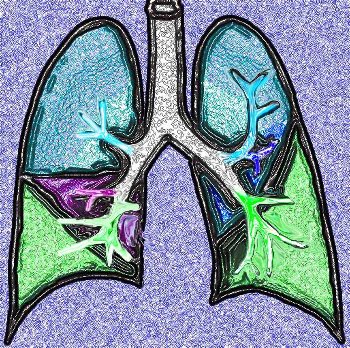 Branching pattern Branching pattern |
| This diagram shows the basic division of the tracheobronchial tree into lobes. The right lung is divided into right upper (RUL) right middle, (RML) and right lower lobe (RLL). The left lung is divided into left upper (LUL), which includes the lingula, and left lower lobe (LLL). Note that the two mainstem bronchi are of unequal length and size. The right mainstem is short and fat while the left is long and thin. This irregular dichotomous branching pattern is characteristic of the branching pattern of all the conducting systems within the lungs.
Image Courtesy Ashley Davidoff MD. 32686b05 |
The accompanying arteries include the main pulmonary artery (MPA), the right pulmonary artery (RPA), and the left pulmonary artery (LPA). The lobar arteries, segmental and subsegmental arteries follow, which finally become the arterioles which are the smallest arteries. When the arteriolar wall becomes one cell layer thick it is called a capillary.
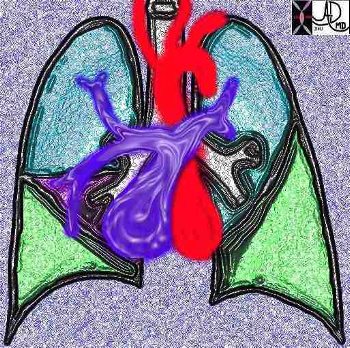
Branching pattern of arteries |
| This diagram shows the right ventricle and lobar pulmonary arteries in blue and the left ventricle and aorta in red. Note that the lobar pulmonary arteries have the same irregular dichotomous branching pattern as the lobar bronchi and give 3 major branches to the right lung (RUL, RML and RLL arteries) and two to the left (LUL and LLL pulmonary arteries). As you will see and learn later, even the position and direction of the main pulmonary arteries in relation to the main stem bronchi are asymmetrical. Courtesy Ashley Davidoff MD 32687b01 |
The bronchovascular bundle, as the name implies, consists of a combination of bronchi and vessels (in this case arteries), and it is positioned in the middle of the pulmonary lobule. The lobule (aka secondary lobule) is the unit of lung parenchyma consisting of 3-5 respiratory bronchioles with their progeny of alveolar ducts sacs and alveoli, which are surrounded by a membrane of connective tissue that contains lymphatics and venules. We will describe this unit extensively in a coming section. The position of bronchovascular bundle is thus centrilobular, meaning that it is in the center of the lobule, while the venous and lymphatic conduits are distributed around the periphery of the lobules. Lymphatics sometimes accompany the bronchovascular bundle as well.
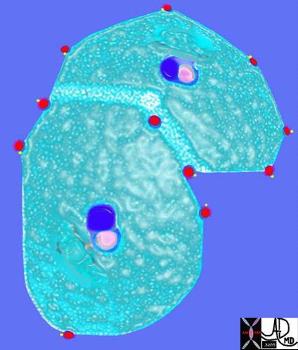 Branching pattern of arteries Branching pattern of arteries |
| The arteries and airways pair up and travel together down the respiratory tree branching in exactly the same way until they reach the pulmonary lobule. The pulmonary lobule, also called the secondary lobule is a structural unit surrounded by a membrane of connective tissue, and it is smaller than a subsegment of lung but larger than an acinus. This diagram shows two secondary lobules lying side by side. The pulmonary arteriole (royal blue) and bronchiole (pink) are shown together in the centre of the lobule (“centrilobular”), while the oxygenated pulmonary venules (red) and lymphatics (yellow) are peripheral and also form a formidable and almost inseparable pair .Courtesy Ashley Davidoff MD 42440b01 |
Venous drainage is usually Evia one major upper lobe and one major lower lobe pulmonary vein to each lung, but clinically significant variations do exist. Segmental subsegmental veins and venules are the equivalent subdivisions of the veins. The capillaries surround the alveoli.
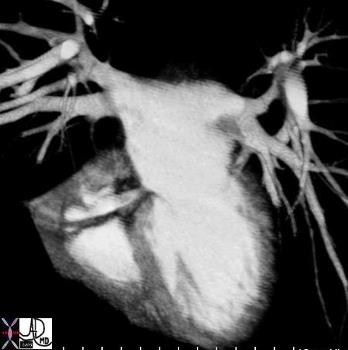 pulmonary veins pulmonary veins |
| This reformatted image shows the classical branching pattern of the pulmonary veins with two upper and two lower lobe veins on either side. This reformatted image shows the classical branching pattern of the pulmonary veins with two upper and two lower lobe veins on either side.
Courtesy Ashley Davidoff MD.37756b01 |
Interactions
Biological units interact with the forces of the environment resulting in a change. The interaction of the lungs with the gases of the air, and then the alveoli with the blood vessels create a system for the filtration delivery and excretion of both wanted and unwanted gases. The two laters of pleura are attached to each other by capillary forces and are attached to the lungs and these interactions allow the chest and lungs to expand together.
States of Being
There are states of order and states of disorder. In the extreme we have life and death, and in between the lungs exist between states of relative order and states of relative disorder. Under normal states of health the process and delivery is a master in design and efficiency. The common states of disorder relate to either airway disease or filter disease.
Health Disease
Most of the time the lung works quietly and efficiently with little fanfare. Diseases desribed above are often linked to behavioral factors such as cigarette smoking and environmental factors such as infections or allergies. When disorder strikes it becomes a very uncomfortable existsnce as the patient fights for each breath. Mechanical ventilators are sometime necessary to help with the mechanical malfunction of the lungs.
Diagnosis and Treatment
In the clinical world the sounds of air movement are caused by turbulent airflow and these sounds are evaluated by the stethoscope. The stethoscope is also a simple tubular structure with a membrane on its far end. There is normal airway turbulence in the larger airways and so it is normal to hear air movement in the lungs during inspiration and expiration. Inspiration is noisier and shorter in duration than expiration. The larger the diameters of the airway, the higher the pitch of the sound, while the smaller the diameter, the lower the pitch.
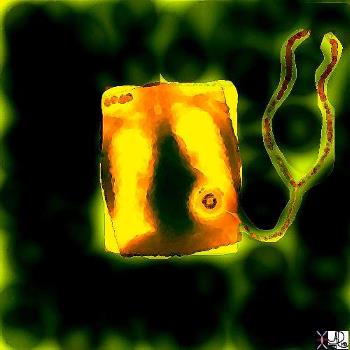 The stethoscope and flow The stethoscope and flow |
| The clinician uses a tubular system called the stethoscope of course, to examine air flow through the tracheobronchial tree. The key in patient care is to combine the clinical knowledge with the imaging. Neither can stand alone.
Courtesy of Ashley Davidoff M.D 32467b05 |
With anaphylaxis or foreign body inhalation, there is partial obstruction of the upper airways and an audible high pitched sound on inspiration can be heard. This sound is called stridor. If the stridor is caused by anaphylaxis then epinephrine may be required, whereas if it is caused by aspiration of a piece of poorly chewed steak then the Heimlich maneuver is required. If you are in a restaurant when a patron clutches his throat and stridorous noises are heard, the question to ask would be “meat or shrimp?” If the person were eating steak then the Heimlich maneuver would be indicated, and if it were shrimp and accompanying signs of hives and facial swelling were present and severe enough, epinephrine would be necessary. Either way, acute stridor is a serious and life threatening situation.
In an acute asthmatic attack the problem lies in the smaller airways. As stated above, in the normal patient, flow at this level is usually inaudible because of its laminar nature. The narrowing caused by muscle spasm and secretions occurs at the level of the smaller bronchi and the turbulence that results is heard as a wheezing sound on expiration. Why expiration and not inspiration? Good question. On inspiration the chest cavity expands and so do the alveoli and bronchioles. The change in size of the bronchioles with inspiration is often sufficient to allow laminar flow to persist, and hence no sound will result. On expiration the diminishing size of the chest cavity causes the bronchioles to recoil, resulting in a smaller diameter, and together with the spasm will result in air trapping, turbulence and wheezing. If the spasm is severe, there may be wheezing both on inspiration as well as expiration. Emphysema and chronic bronchitis are also causes of wheezing during exhalation. In all these conditions the overall intake of air exceeds the volume exhaled, and so the net result is air trapping and increase in the lung volume.
If there is a large amount of air trapping the radiologist will see the larger air volumes as hyperexpanded or hyperinflated lungs. In such cases, if one counts the posterior ribs on the CXR, more than 10 posterior ribs will be visualized above the diaphragm. Flattening of the diaphragms also will occur and is best seen on the lateral CXR. Since a large portion of the air seen in the large lungs is static air, it will contain a higher level of carbon dioxide and relatively lower levels of oxygen. In severe asthma poor oxygenation of the blood results andoxygen saturation falls. The air trapping seen in emphysema is caused by a loss of elasticity of the alveoli and abnormal overexpansion of the alveoli.Withlarger surface areas and hence volumes there is an increase ventilation (V) without an overall appropriate increase in perfusion (Q), resulting in a V/Q mismatch, and thus inadequate gas exchange.
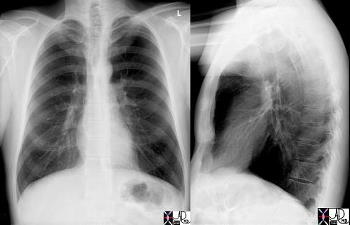 The stethoscope and flow The stethoscope and flow |
| The P-A view of the chest shows hyperinflated lung volumes. Note that more than 10 posterior ribs can be visualized. The lateral view of the chest shows hyperinflated lung volumes in this patient with acute asthma, characterized by flattening of the hemidiaphragms and increased aeration of the retrosternal air space.
Courtesy of: Ashley Davidoff, M.D 41987c |
